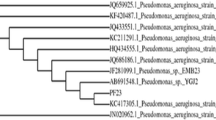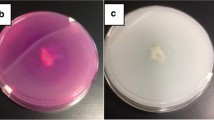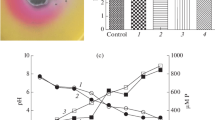Abstract
Exopolysaccharides (EPS) producing Pseudomonas aeruginosa PF23EPS+ and its mutant PF23EPS− (EPS deficient strain) taken from authors collection were monitored for salicylic acid (SA) production. Strain PF23EPS+ displayed SA production and biocontrol against phytopathogen Macrophomina phaseolina up to 500 mM NaCl. However, mutant was defective in EPS production and displayed significant reduction in SA production under non-stress conditions. The mutant neither displayed SA production nor biocontrol against phytopathogen at diverse salt concentrations, authenticating the relation of SA in antagonism. Pot and field trials were conducted in salinized soil infested with M. phaseolina taking sunflower as test crop. Results of field study were in agreement with the findings of pot study. The combination of strain PF23EPS+ and extracted SA obtained from it brought significant enhancement in plant growth parameters and reduction of disease incidence under saline conditions. The study reports the application of plant growth promoting (PGP) microbe P. aeruginosa PF23 and its metabolite (SA) for enhancing growth of sunflower crop in salinized soil infested with M. phaseolina.



Similar content being viewed by others
References
Amira MS, Qados A (2015) Effects of salicylic acid on growth, yield and chemical contents of pepper (Capsicumannuum l) plants grown under salt stress conditions. Inter J Agri Crop Sci 8:107–113
Arora NK (2015) Plant microbe symbiosis: applied facts. Springer, New Delhi, pp 1–381
Arora NK, Mishra J (2016) Prospecting the roles of metabolites and additives in future bioformulations for sustainable agriculture. Appl Soil Ecol 107:405–407
Arora NK, Tewari S, Singh S, Lal N, Maheshwari DK (2012) PGPR for protection of plant health under saline conditions. In: Maheshwari DK (ed) Bacteria in agrobiology: stress management. Springer, Berlin, pp 239–258
Arora NK, Mehnaz S, Balestrini R (2016) Bioformulations: for sustainable agriculture. Springer, New Delhi, pp 1–283
Chao TC, Buhrmester J, Hansmeier N, Puhler A, Weidner S (2005) Role of the regulatory gene rirA in the transcriptional response of Sinorhizobium meliloti to iron limitation. Appl Environ Microbiol 71:5969–5982
Dempsey DA, Klessig DF (2017) How does the multifaceted plant hormone salicylic acid combat disease in plants and are similar mechanisms utilized in humans? BMC Biol 15:23
El Midaoui M, Talouizte A, Benbella M, Serieys H, Griveau Y, Berville A (2001) Effect of osmotic pressure on germination of sunflower seeds (Helianthus annuus L.). Helia. 24:129–134
El Oirdi M, El Rahman TA, Rigano L, El Hadrami A, Rodriguez MC, Daayf F, Vojnov A, Bouarab K (2011) Botrytis cinerea manipulates the antagonistic effects between immune pathways to promote disease development in tomato. Plant Cell 23:2405–2421
Flagella Z, Di Caterina R, Monteleone M, Giuzio L, Pompa M, Tarantino E, Rotunno T (2004) Potentials for sunflower cultivation for fuel production in southern Italy. Helia. 29:81–88
Flowers T (2004) Improving crop salt tolerance. J Exp Bot 55:307–319
Horvath E, Szalai G, Janda T (2007) Induction of abiotic stress tolerance by salicylic acid signaling. J Plant Growth Regul 26:290–300
Hu Y, Schmidhalter U (2005) Drought and salinity: a comparison of their effects on the mineral nutrition of plants. J Plant Nutr Soil Sci 168:541–549
Jones JD, Dangl JL (2006) The plant immune system. Nature 444:323–329
Joshi KK, Kumar V, Dubey RC, Maheshwari DK (2006) Effect of chemical fertilizer adaptive variants, Pseudomonas aeruginosa GRC2 and Azotobacter chroococcum AC1 on Macrophomina phaseolina causing charcoal rot of Brassica juncea. Korean J Environ Agr 25:228–235
Kaya DJ, Kirnak H, Higgs D, Saltali K (2002) Supplementary calcium enhances plant growth and fruit yield in strawberry cultivars grown at high salinity. Sci Hortic 93:65–74
Khan SN (2007) Macrophomina phaseolina as causal agent for charcoal rot of sunflower. Mycopath 5:111–118
Khan MH, Panda SK (2008) Alterations in root lipid peroxidation and antioxidative responses in two rice cultivars under NaCl-salinity stress. Acta Physiol Plant 30:89–91
Khan AN, Shair F, Malik K, Hayat Z, Khan MA, Hafeez FY, Hassan MN (2017) Molecular identification and genetic characterization of Macrophomina phaseolina strains causing pathogenicity on sunflower and chickpea. Front Microbiol 8:1–11
Khare E, Singh S, Maheshwari DK, Arora NK (2011) Suppression of charcoal rot of chickpea by fluorescent pseudomonas under saline conditions. Curr Microbiol 62:1548–1553
Kolte SJ (2018) Diseases of annual edible oilseed crops: volume III: sunflower, safflower, and nigerseed diseases. CRC Press, Boca Raton, pp 1–168
Kunkel BN, Brooks DM (2002) Cross talk between signaling pathways in pathogen defense. Curr Opin Plant Biol 5:325–331
Lamothe RG, El Oirdi M, Brisson N, Bouarab K (2012) The conjugated auxin Indole-3-Acetic Acid–aspartic acid promotes plant disease development C. Plant Cell 24(2):762–777
Leigh JA, Signer ER, Walker GC (1985) Exopolysaccharide-deficient mutants of Rhizobium meliloti that form ineffective nodules. Proc Natl Acad Sci 82:6231–6235
Maheshwari DK, Dubey RC, Abhinav A, Kumar B, Kumar S, Tewari S, Arora NK (2012) Integrated approach for disease management and growth enhancement of Sesamum indicum L. utilizing Azotobacter chroococcum TRA2 and chemical fertilizer. World J Microbiol Biotechnol 28:3015–3024
Mehran S, Ahmad N, Seyed AS, Tayeb S, Shahram L (2013) Effect of salicylic acid pretreatment on germination of wheat under drought stress. J Agri Sci 5:179–199
Meyer GD, Hofte M (1997) Salicylic acid produced by the rhizobacterium Pseudomonas aeruginosa 7NSK2 induces resistance to leaf infection by Botrytis cinerea on Bean. Bio Con 89:588–593
Mishra J, Arora NK (2018) Secondary metabolites of fluorescent pseudomonads in biocontrol of phytopathogens for sustainable agriculture. Appl Soil Ecol 125:35–45
Morohoshi T, Nakamura Y, Yamazaki GO, Ishida A, Kato N, Ikeda T (2007) The plant pathogen Pantoea ananatis produces N-Acylhomoserine lactone and causes center rot disease of onion by quorum sensing. J Bacteriol 189:8333–8338
Mostafavi K, Heidarian AR (2012) Effect of salinity different levels on germination indices in four varieties of sunflower (Helianthus annuus L.). Inter Res J App Basic Sci 3:2043–2051
Munns R (2002) Comparative physiology of salt and water stress. Plant Cell Environ 25:239–250
Nazar R, Iqbal N, Syeed S, Khan NA (2011) Salicylic acid alleviates decreases in photosynthesis under salt stress by enhancing nitrogen and sulfur assimilation and antioxidant metabolism differentially in two mungbean cultivars. J Plant Physiol 168:807–815
Nehal S, Mougy El (2004) Preliminary evaluation of salicylic acid and acetylsalicylic acid efficacy for controlling root rot disease of lupin under greenhouse conditions. Egypt J Phytopathol 32:11–21
Parvaiz A, Satyawati S (2008) Salt stress and phyto-biochemical responses of plants—a review. Plant Soil Environ 54:88–99
Paul D, Nair S (2008) Stress adaptations in a plant growth promoting rhizobacterium (PGPR) with increasing salinity in the coastal agricultural soils. J Basic Microbiol 48:378–384
Prashar P, Kapoor N, Sachdeva S (2013) Biocontrol of plant pathogens using plant growth promoting bacteria. In sustainable agriculture reviews. Springer, The Netherlands, pp 319–360
Prıncipe A, Alvarez F, Castro MG, Zachi L, Fischer SE, Mori GB, Jofre E (2007) Biocontrol and PGPR features in native strains isolated from saline soils of Argentina. Curr Microbiol 55:314–322
Rad UV, Klein I, Dobrev PI, Kottova J, Zazimalova E, Fekete A, Hartmann A, Schmitt-Kopplin P, Durner J (2008) Response of Arabidopsis thaliana to N-hexanoyl-dl-homoserinelactone, a bacterial quorum sensing molecule produced in the rhizosphere. Planta 229:73–85
Raheleh A, Manoochehr M, Masoud Z, Mohammad JR (2013) The effects of seed priming with salicylic acid on the growth of maize under salinity conditions. Int J Agr Crop Sci 5:1820–1826
Ran LX, Li ZN, Wu GJ, Van Loon LC, Bakker PAHM (2005) Induction of systemic resistance against bacterial wilt in Eucalyptus urophylla by fluorescent Pseudomonas spp. Eur J Plant Pathol 113:59–70
Roberson EB, Firestone MK (1992) Relationship between desiccation and exopolysaccharide production in a soil Pseudomonas sp. Appl Environ Microbiol 58:1284–1291
Sakhabutdinova AR, Fatkutdinova DR, Bezrukova MV, Shakirova FM (2003) Salicylic acid prevents the damaging action of stress factors on wheat plants. Bulg J Plant Physiol 21:314–319
Schuhegger R, Alexandra I, Stephan G, Günther B, Claudia K, Gerd V, Peter H, Michael S, Frank VB, Leo B, Anton H, Christian L (2006) Induction of systemic resistance in tomato by N-acyl-l-homoserine lactone-producing rhizosphere bacteria. Plant Cell Environ 29:909–918
Shahzad R, Khan AL, Bilal S, Asaf S, Lee IJ (2017) Plant growth-promoting endophytic bacteria versus pathogenic infections: an example of Bacillus amyloliquefaciens RWL-1 and Fusarium oxysporum f. sp. lycopersici in tomato. Peer J 5:e3107
Shanmugam P, Narayanasamy M (2008) Optimization and production of salicylic acid by rhizobacterial strain Bacillus licheniformis MML2501. Internet J Microbiol 6:1
Tanaka S, Han X, Kahmann R (2015) Microbial effectors target multiple steps in the salicylic acid production and signaling pathway. Front Plant Sci 6:349
Tewari S, Arora NK (2013) Transactions among microorganisms and plant in the composite rhizosphere habitat. In: Arora NK (ed) Plant microbe symbiosis: fundamentals and advances. Springer, New Delhi, pp 1–50
Tewari S, Arora NK (2014a) Multifunctional exopolysaccharides from Pseudomonas aeruginosa PF23 involved in plant growth stimulation, biocontrol and stress amelioration in sunflower under saline conditions. Curr Microbiol 69:484–494
Tewari S, Arora NK (2014b) Talc based exopolysaccharides formulation enhancing growth and production of Hellianthus annuus under saline conditions. Cell Mol Biol 60:73–81
Tewari S, Arora NK (2016) Fluorescent Pseudomonas sp. PF17 as an efficient plant growth regulator and biocontrol agent for sunflower crop under saline conditions. Symbiosis. https://doi.org/10.1007/s13199-016-0389-8
Thenmozhi P, Dinakar S (2014) Original research article exopolysaccharides (EPS) mediated Induction of systemic resistance (ISR) in Bacillus-Fusarium oxysporum f. sp. lycopersici pathosystem in tomato (var. PKM-1). Int J Curr Microbiol App Sci 3:839–846
Toiu A, Laurian V, Lioara O, Daniela B, Mircea T (2011) HPLC analysis of salicylic derivatives from natural products. Farmacia 59:106–112
Ullah MH, Khan MA, Sahi ST, Habib A (2011) Evaluation of antagonistic fungi against charcoal rot of sunflower caused by Macrophomima phaseolina (Tassi) Goid. J Appl Sci Res 2:1175–1184
United States Department of Agriculture (2015) http://www.usda.gov/wps/portal/usda/usdahome
Upadhyay SK, Singh JS, Singh DP (2011) Exopolysaccharide–producing plant growth- promoting rhizobacteria under salinity condition. Pedospher 21:214–222
Upadhyay A, Kochar M, Rajam MV, Srivastava S (2017) Players over the Surface: unraveling the Role of Exopolysaccharides in Zinc Biosorption by Fluorescent Pseudomonas Strain Psd. Front Microbiol 8:284
Validov S, Kamilova F, Qi S, Stephan D, Wang JJ, Makarova N, Lugtenberg B (2007) Selection of bacteria able to control Fusarium oxysporum f. sp. radicis-lycopersici in stonewool substrate. J Appl Microbiol 102:461–471
Wang D, Pajerowska-Mukhtar K, Culler AH, Dong X (2007) Salicylic acid inhibits pathogen growth in plants through repression of the auxin signaling pathway. Curr Biol 17:1784–1790
Weidenborner M, Uziel M, Hamacher J, Hindorf H, Weltzien HC (1989) A preparation method of Aspergillus spp. for scanning electron microscopy. J Phytopathol 126:1–6
Yan H, Zhang S, Li C, Liu L, Zhang T, Jiu WS (2014) Effect of salicylic acid on polysaccharide and microcystin contents in Microcystis aeruginosa PCC7806. J Hygine Res 43:290–295
Yuan ZC, Elise H, Denis F, Kathleen FK, Eugene WN (2008) Comparative transcriptome analysis of Agrobacterium tumefaciens in response to plant signal salicylic acid, Indole-3-acetic acid and γ-amino butyric acid reveals signalling cross-talk and Agrobacterium—plant coevolution. Cell Microbiol 10:2339–2354
Zipfel C (2009) Early molecular events in PAMP-triggered immunity. Curr Opin Plant Biol 12:414–420
Acknowledgments
Authors are obliged to Vice Chancellor, BBA University, Lucknow, UP, India for support.
Author information
Authors and Affiliations
Corresponding author
Rights and permissions
About this article
Cite this article
Tewari, S., Arora, N.K. Role of salicylic acid from Pseudomonas aeruginosa PF23EPS+ in growth promotion of sunflower in saline soils infested with phytopathogen Macrophomina phaseolina. Environmental Sustainability 1, 49–59 (2018). https://doi.org/10.1007/s42398-018-0002-6
Received:
Revised:
Accepted:
Published:
Issue Date:
DOI: https://doi.org/10.1007/s42398-018-0002-6




